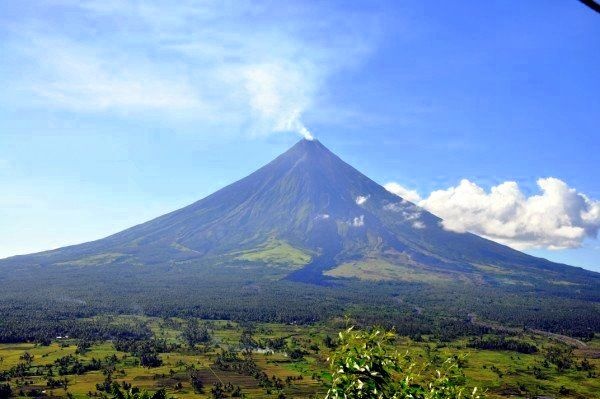LEGAZPI CITY – A government geologist believes the continuing push of magma against the weight of the lava dome at the crater of Mayon Volcano would determine when it would erupt and how strong the eruption would be.
Win Sevilla, Philippine Institute of Volcanology and Seismology (Phivolcs) senior geologist, said the continuing magma push to the surface over the weight of the lava dome clogging the vent of Mayon might trigger an eruption.
The latest ground deformation leveling survey yesterday showed that Mayon’s surface had again inflated by 4.21 millimeters in just a week’s time, faster than its previous inflation rate of 13 millimeters in over a month from September, he added.
Phivolcs recorded yesterday only a rockfall event and 444 tons of sulfur dioxide, higher than the other day’s emission (148 tons), but lower than the baseline of 500 tons a day.
Since Mayon was placed under Alert Level 3, the surface had already inflated by 17 millimeters. Mayon’s 2009 eruption began when its inflation reached at least 20 millimeters.
However, Sevilla said Mayon had no patterned surface inflation measurements in the past that would determine the date of an eruption.
“There is a serious magma rise inside the volcano,” he said. “The ascent is becoming faster in the recent surveys compared to the previous.”
Sevilla said this faster magma push to the surface is being aggravated by the drop in sulfur dioxide.
“Should this magma ascent continue while the gas emission is very low due to the clogged crater, a strong eruption is very likely to take place,” he said.
Sevilla said an eruption is anticipated once the magma pressure prevails over the lava dome.
These fighting of forces might take some time, depending on the magma pressurization inside the volcano’s conduit, he added.
Sevilla said it took them 149 days and 24 days to raise Mayon’s alert level 3 to 4 in the 2001 and 2009 eruptions.
“Once Mayon displayed a lava dome in its crater, it will erupt,” he said.
Wildfires
Environment Secretary Ramon Paje has directed concerned officials in Albay to tap various Regional Forest Fire Respondent Teams (RFFRTs) in case wildfires break out when Mayon Volcano erupts.
RFFRTs are composed of special units called “Leatherbacks” coming from Department of Environment and Natural Resources (DENR) field offices, Bureau of Fire Protection (BFP) and volunteer groups.
They are tasked to conduct round-the-clock monitoring and initiate quick response during wildfires.
Paje said these teams underwent intensive training and are placed on standby near areas vulnerable to forest fires.
“We have to be ready for potential wildfires, including whatever intervention may be needed to protect natural ecosystems that are highly vulnerable to catastrophic damage the volcanic explosion may cause,” he said.
The DENR is now preparing thematic maps and the profile of timberlands and protected areas in the region that will serve as guide in the posting of the RFFRTs.
The maps will include trails and access roads, location of water sources and forest ranger stations.
Paje warned that volcanic eruptions and wildfires pose serious hazards not only to the population but also to the surrounding natural ecosystems.
Paje also ordered forestry officials to ensure the protection of the seedlings to be planted at the foot of Mayon under the National Greening Program (NGP), particularly those within the 76,770-hectare Quinale watershed traversing the base of the volcano and including some areas within the six-kilometer permanent danger zone.
The watershed area is an NGP priority in Albay due to its importance to the province’s irrigation needs and agricultural activities, as well as in terms of flood prevention especially in the towns of Oas, Polangui and Libon and the city of Ligao, he added.
US aid
The US is handing out P4.4 million for displaced families living around Mayon Volcano.
US Ambassador Philip Goldberg said the US stands ready to help families cope with the challenges posed by the temporary displacement.
“The US government will continue to monitor the Mayon situation and work with Philippine authorities to help the affected families,” he said.
The United States Agency for International Development (USAID) will provide emergency sanitation, hygiene and non-food items to families seeking temporary refuge in evacuation centers located in the municipalities of Guinobatan, Camalig and Daraga.
The humanitarian assistance, which will be distributed by World Vision for USAID, will focus on improving access to safe drinking water, functioning latrines and temporary classrooms.
Goldberg also expressed support to Albay Gov. Joey Salceda’s “zero casualty objective” and commended all the brave families that participated in an orderly and successful pre-emptive evacuation.
US government disaster-assistance funding over the last 10 years has amounted to P8.1 billion.
Beyond immediate disaster relief, the US government also supports the Philippines in strengthening the capacity of communities to mitigate, prepare for and respond to natural disasters and the effects of climate change.
The provincial government of Albay has evacuated more than 12,000 families living within the six-kilometer radius permanent danger zone after Phivolcs placed Mayon Volcano under Alert Level
source: ph.news.yahoo.com/magma-push-lava-dome-determine-000000999.html
‘Magma push on lava dome will determine Mayon eruption’
Posted on at




